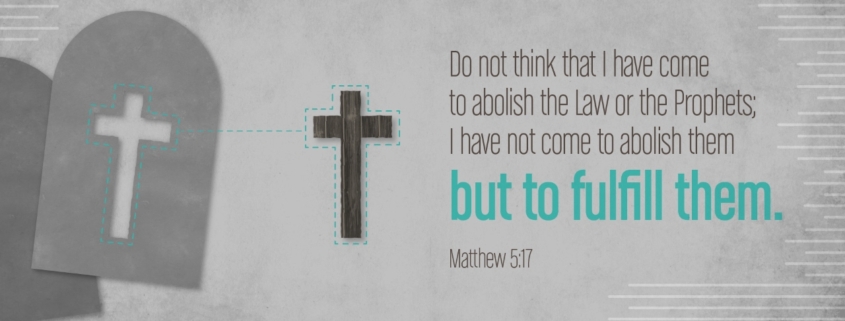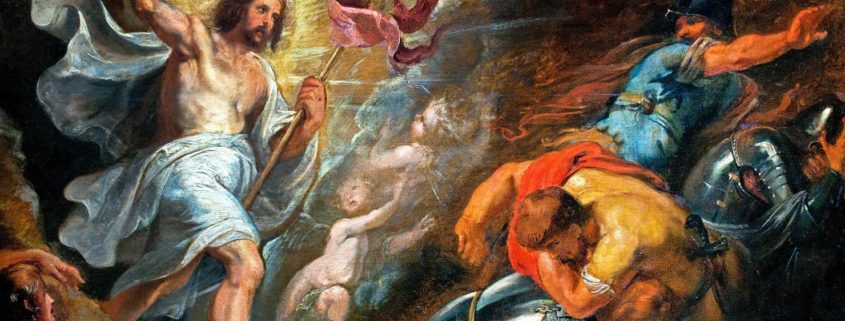Posts
My latest for Catholic Answers Magazine.
Once, in Jerusalem, I was privileged to attend Mass with a group of Catholics who had converted from Judaism and celebrated the Mass in Hebrew. None of those present who had come to believe in Yeshua HaMashiach (Jesus the Messiah) would have said they had “changed religions.” They didn’t view the Catholic Church as a new religion that had replaced Judaism—rather, it was Judaism, but with the Messiah having come.
For these converts, many facets of New Covenant worship evoked elements of the Old: features such as the tabernacle, the ambo, and the altar made sense to them in a way that they may not for those who convert to Catholicism from non-Christian or Protestant Christian backgrounds. And the similarities didn’t end with liturgy. They didn’t see Catholicism’s doctrines as something foreign, either. Rather, they saw the continuity, the inner logic, of Jesus’ teachings vis-a-vis the Old Testament.
Considering that Jesus of Nazareth was a faithful Jew, this really shouldn’t be a surprise. Yet throughout the centuries until now, many theologians and scholars have believed the opposite: that Jesus broke clean with the Old Covenant religion of his day, railing against its “legalism” and focusing instead entirely on God’s mercy and love.
Without a doubt, Jesus delighted in dispensing God’s mercy to those who repented of sin. But there is no opposition between mercy and law. In fact, in so many ways, God’s law is an expression of his mercy. A careful reading of the New Testament shows that Jesus was in no way opposed the law given to Moses.
Open your Bible and let’s take a look together.
For example: in the Gospel of Matthew Jesus gives five major discourses that represent the crucial emphases of his teaching that the evangelist wished to impart to his audience. The first is the Sermon on the Mount, in chapters 5-7. The second is the Missionary Discourse in chapter 10, followed by the Parabolic Discourse in chapter 13 and the Community Discourse in chapter 18. The fifth and final speech is the Eschatological Discourse in chapters 24-25.
We have several reasons to believe that Matthew intentionally arranged this material into five “teaching blocks.” First, there are literary clues. Each discourse concludes with the verb telein (“to finish”—cf. Matt. 7:28, 11:1, 13:53, 19:1, 26:1). This corresponds to verbiage from the Pentateuch: “When Moses finished (suntelein) speaking all these words” (Deut. 31:1; cf. Num. 16:31; Deut. 31:24, 32:45).
I’ve discussed elsewhere how Jesus is presented in Matthew as a new Moses. Matthew’s arrangement of Christ’s teaching into five narrative segments is meant to allude to the five books of Moses, the first five books of the Hebrew Bible. Why? In large measure to deal with the allegations of some Jews that Jesus and his followers intended to abolish the Law of Moses. This is an important theme in Matthew’s Gospel, intended as it is for a primarily Hebrew audience.
The number five (are you sensing a theme here?) comes into play most clearly in the material following Matthew 5:17-20, which is the key passage, in many ways, to understanding the Sermon on the Mount. In these verses, Jesus explains that he has “not come to abolish the law, but to fulfill” (v. 17), and that “until heaven and earth pass away, not one letter, not one stroke of a letter, will pass from the law until all is accomplished” (v. 18). Jesus also states that lawbreakers (such as he is accused of being) “will be called least in the kingdom of heaven; but whoever does them and teaches them (the commandments of the law) will be called great in the kingdom of heaven” (v. 19).
Then Jesus states that, in order to enter the kingdom of heaven, one’s “righteousness” must be greater than that of the scribes and Pharisees (v. 20). This is truly a remarkable statement, because in Jesus’ day those very scribes and Pharisees were considered theauthority on the interpretation of the Law of Moses.
This highlights the main issue: who has the true interpretation of the law? Jesus and his followers? The Pharisees and scribes? Some other group?
Jesus goes on to show, by means of a series of five “antitheses” (“You have heard it said . . . but I say to you”), that his interpretation of the law, as practiced by himself and his followers, is the true interpretation—and indeed, the fulfillment—of the law given to Moses. These five antitheses correspond to the five fulfilments of Old Testament prophecy given in the infancy narrative of Matthew (1:22-23, fulfilling Isaiah 7:14; 2:5-6, fulfilling Micah 5:2; 2:15, fulfilling Hosea 11:1; 2:17-18, fulfilling Jeremiah 31:15; and 2:23, which summarizes Judges 13:5 and Isaiah 11:1). Together, they make a powerful case that Jesus has come to fulfill the law and the prophets.
Specifically, the five antitheses of the Sermon on the Mount fulfill five aspects of the books of Moses: Deuteronomy 5:17 is fulfilled in Matthew 5:21; Exodus 20:14 is fulfilled in Matthew 5:27; Leviticus 19:12 is fulfilled in Matthew 5:33; Exodus 21:23-25 is fulfilled in Matthew 5:38; and Leviticus 19:17-18 is fulfilled in Matthew 5:43.
Many “historical Jesus” scholars, when assessing whether Jesus could have plausibly taught what the Gospels claim he did, are fond of employing something called the criterion of double dissimilarity. “If something sounds too much like the teaching of Judaism,” the thinking goes, “or too much like later Church teaching, Jesus probably didn’t say it.” That has always sounded ridiculous to me, considering that Jesus was Jewish and that he founded the Church! We should expect to find an abundance of continuity between the Old Testament, the teaching of Jesus, and that of the Church. And this is exactly what we do find.
And here’s one final, commonsense fact: if Jesus, as many caricatures of him suggest, really represented a radical break with Jewish teaching, there is simply no plausible way he would have garnered such a massive following among his fellow Israelites. No one would have believed that he was the promised Messiah if he had rejected the Law of Moses!
It seems reasonable, then, to believe the opposite, which is exactly what Jesus set out to do: not to abolish the law but to fulfill it (Matt. 5:17).
Here’s my latest piece for Catholic Answers. Hope you enjoy it. — Cale
Every Easter season we encounter articles, documentaries, books, and news reports suggesting that the canonical Gospels got the Resurrection wrong. Scholars with impressive credentials appear in the media to tell us that, if we want the full story about Easter, we must turn to what are known as the apocryphal Gospels.
It often comes as a surprise to Christians to learn that there were many other “Gospels” that circulated in the decades and centuries after the composition of Matthew, Mark, Luke, and John, but never made it into the New Testament. Some of these have survived to our day, to the fascination of scholar and layman alike. But do these works indeed provide credible information about Jesus that isn’t in the Bible?
A professor of mine always gave this advice to students who were curious about these writings: “Just read them,” he said, “and ask yourself this question: do you really think they smack of authenticity?” Some of the scholars who champion the apocryphal Gospels imply that the Church hid these documents from the people because they contain the “real” story about Jesus. But reading them, as Dr. Evans knew, shows that the Church had very good reasons for not canonizing these works. Far from radiating authenticity, they come across as quite strange and not reliable historically.
Let’s take one example of these texts, the Gospel of Peter, and compare its Easter narrative to that in the Gospel of Matthew.
Matthew’s account of the Resurrection, written in the first century, is sober and rather restrained—especially compared with the account in the Gospel of Peter, a highly embellished collection of legends likely written in the second century. (No, it wasn’t actually written by Peter, don’t worry—later writers would attribute their works to apostles in an attempt to gain credibility).
Far from being an early, original source of material on the life of Jesus, the Gospel of Peter is actually dependent on the canonical Gospel of Matthew for much of its content. Its unbelievable reworking of the Resurrection account in Matthew includes—get this—a talking cross that emerges from Jesus’ tomb along with the risen Jesus and two angels, all of whom are so tall that their heads are, quite literally, in the clouds (39-43). It also mentions many other elements that a Jewish audience would find implausible and ahistorical, such as members of the Jerusalem religious elite pitching tents and sleeping among the tombs with Roman soldiers, making sure Jesus stays dead (33, 38). Ever heard of uncleanness and ritual impurity? Hello!
The Gospel of Peter therefore lacks what is called verisimilitude. Its miraculous details seem purposely fantastic. It doesn’t cohere with the way things actually were in Jesus’ time and place. Readers of Matthew’s Easter account, especially those of a Jewish background, would have found its Easter account much more credible and persuasive. Let’s look at some of its details.
Facets of Matthew’s account of Jesus’ burial later become important proofs for Jesus’ resurrection. The mention of Joseph of Arimathea’s donation of a new tomb for Jesus burial (Matt. 27:57-61) is significant. Joseph, who is mentioned in all four Gospels and undoubtedly a historical personage, was a member of the Sanhedrin, and thus a known public figure. This means that the location of Jesus’ tomb was also known to friend and foe alike. If Jesus’ remains were still entombed following Easter, it would have been easy to prove this by searching Joseph’s tomb. However, even the enemies of the nascent Christian movement do not dispute the empty tomb (Matt. 28:11-15). Matthew also notes that many of Jesus’ women followers saw the place where Jesus was buried (27:56; 27:61; 28:1-8), discrediting any theory that the women went to the wrong tomb on Sunday morning.
Among the canonical Gospels, only Matthew’s mentions the presence of Roman guards at the tomb, a point that many critics of the Gospel dispute. The Gospel of Peter also mentions the guards, though again with legendary accretions. Even so, this demonstrates that the guard account was an enduring aspect of the apologetic for the Resurrection. Therefore it is more certain, from a historical perspective, that guards were in fact present.
The chief priests, after hearing “everything that had happened” from the guards, bribed the soldiers to propagate the story that the disciples of Jesus stole his body from the tomb while they slept (a first-century edition of “fake news,” one might say). Matthew reports that, at the time of the writing of his Gospel, this version of events was still being told among the Jews (Matt. 28:11-15). In fact, this story became a well-entrenched facet of an anti-Christian Jewish apologetic, for Justin Martyr, writing in the second century A.D.,states that it was still being circulated in his time.
The guards’ probable historicity is even further bolstered by the edict of Caesar, possibly enacted in Galilee in the first century, decreeing capital punishment for grave robbers. The fact that tampering with Jesus’ tomb would have been punishable by both Jewish and Roman authorities, and that the tomb, according to Matthew, was sealed (Matt. 27:66), make any potential moving of Jesus’ body from the tomb highly unlikely in this case.
Add to that the fact that liars usually make terrible martyrs (why would the disciples later die for their belief in the Resurrection, if they had in fact stolen the body?), and one has a very solid case for the empty tomb. Again, even the enemies of the Christian movement admit the tomb is empty, and enemy attestation is excellent evidence.
But, of course, an empty tomb alone does not a resurrection make. This is why Matthew’s accounts of the appearances of the risen Jesus are so important. That Mary Magdalene and the other women “took hold of his feet” (Matt. 28:9) affirms the corporeal (bodily) nature of Jesus’ resurrection, making the same point as Luke 24:36-43 and John 20:24-29.
Matthew’s very mention of women as the first to discover the empty tomb on Sunday morning, encounter the resurrected Jesus, and inform the male disciples of the event is, in all likelihood, historical. Given the (unfortunately) very biased and low view of the testimony of women in both Jewish and Greco-Roman settings of the time, Matthew (and the other Gospel writers) would never have mentioned this unless it was factual. Consider these quotes from Jewish sources of the general period:
Sooner let the words of the Law be burnt than delivered to women (Talmud, Sotah 19a).
But let not the testimony of women be admitted, on account of the levity and boldness of their sex…since it is probable that they may not speak truth, either out of hope of gain, or fear of punishment (Josephus, Antiquities 4.8.15).
Any evidence which a woman (gives) is not valid (to offer)…This is equivalent to saying that one who is rabbinically accounted a robber is qualified to give the same evidence as a woman (Talmud, Rosh Hashannah 1.8).
The bizarre Gospel of Peter instead describes many prominent maleenemies of Jesus as witnesses to his resurrection. What a stark contrast to Matthew, who not only presents women as the first eyewitnesses of the risen Christ, but does not claim that anyonewitnessed the resurrection event itself. This striking omission, perhaps above all the other differences, testifies to the sober realism of Matthew and the other Gospels over the fantasies of apocryphal texts.
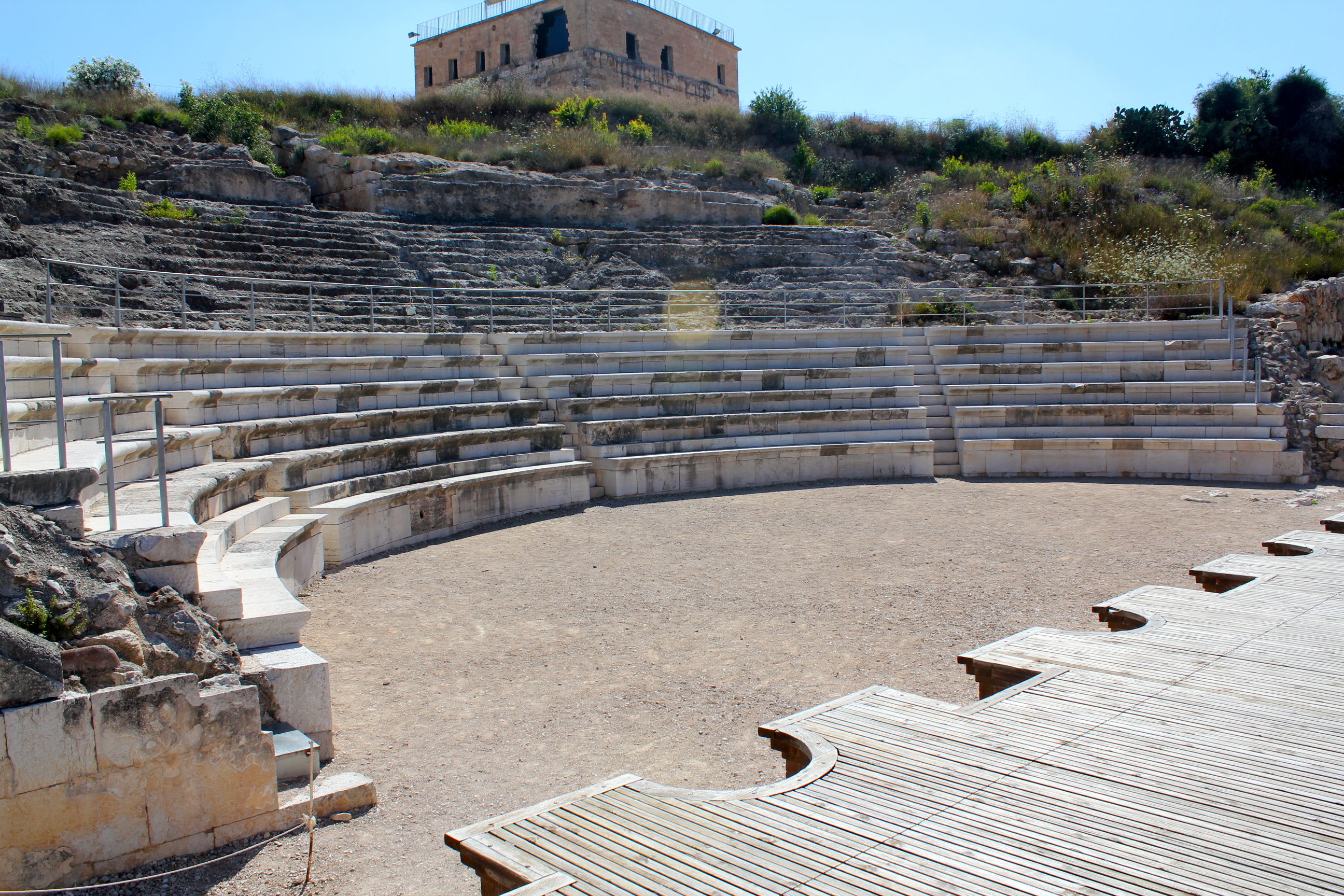
Here’s my latest piece for Catholic Answers Magazine. Hope you enjoy this look at the big city next door to little Nazareth, Jesus’ hometown – and how it may have influenced him.
My favorite basketball player growing up was the legendary Larry Bird of the Boston Celtics. The media (and Larry himself) liked to play up his humble, small-town roots, dubbing him the “Hick from French Lick,” the small Indiana town where Bird grew up. He was just a kid from the sticks who made good.
For centuries, preachers have similarly accented the alleged small-town roots of Jesus. Nazareth, where Jesus grew up, is usually portrayed in homilies as a type of isolated backwater, far removed from the hustle and bustle of the empire.
Now, it’s certainly true that in Jesus’ day Nazareth was relatively tiny, with a population somewhere between 200 and 400. But recent archaeological excavations around Nazareth, which today is a relatively bustling city of about 60,000, have quashed the quaint myth that Jesus grew up among “country bumpkins” removed from major centers of commerce and culture.
One of the most important of these digs took place at Sepphoris, which is located about four miles north of Nazareth. Sepphoris, which Roman historian Josephus called “the ornament of all Galilee,” was the largest and one of the most important cities in the area. In fact, a highway linking the two other major regional centers—Caesarea Maritima and Tiberias—was not far from Nazareth and Sepphoris.
Considering its proximity to Nazareth, it’s highly likely that Jesus would have traveled to Sepphoris on many occasions. In fact, according to an early Church tradition, the Blessed Virgin Mary hailed from Sepphoris. One could easily imagine Jesus, Mary, and Joseph making the trip to see Jesus’ grandparents, Joachim and Anne, on many an occasion.
It is also possible that Joseph and Jesus worked in Sepphoris during its period of heavy expansion under Herod Antipas from 4 B.C. to A.D. 39. The Greek word tekton—which the Gospels employ to describe Jesus’ and Joseph’s occupation—actually means much more than “carpenter.” It refers to a highly skilled laborer who would have been proficient in working with stone as well as wood and other materials. (In fact, it is likely that Joseph and Jesus would have had architectural abilities as well. One might even say they were the equivalent of modern-day engineers.) Antipas had originally intended to make Sepphoris his headquarters, and he installed some beautiful architecture there in the Greco-Roman style, including magnificent colonnaded streets and an impressive theater (more on that later).
The Sepphoris excavations are also important for debunking a popular skeptical theory. The scholar (and ex-Catholic priest) John Dominic Crossan argues that, in his early life, Jesus came under the sway of itinerant Cynic philosophers in Sepphoris who greatly influenced his teaching. But excavations at the city dump have determined that, at the time of Jesus, Sepphoris’s inhabitants were anything but pagan.
Only in strata (layers of cultural remains in the earth, representing different eras) dated after A.D. 70 do we find pig bones and other evidence of Hellenizing influences, consistent with growth in the city’s non-Jewish population following the failed Jewish revolt of 66-70. It seems the citizens of Sepphoris in Jesus’ time kept to a kosher diet.
Furthermore, coins minted in Sepphoris prior to 70 do not depict the image of the emperor as a deity, which would have offended devout Jews, even though such currency was common elsewhere in the empire. After the year 70, this is not the case. Also, stone vessels and miqva’ot (ritual bathing pools) used for Jewish purification rites, as well as menorahs, have also been found from the pre-70 period.
In short, Sepphoris was in all likelihood a mostly—if not completely—Jewish city at the time of Jesus. It is therefore improbable that Jesus came under the sway of pagan Cynics during his early life in and around Nazareth. His teaching, like the area he hailed from, was thoroughly Jewish.
Sepphoris is also a potential boon for understanding and clarifying certain aspects of Jesus’ teachings. We know that Jesus was a master at pointing out profound lessons from the everyday world (for example, his many agricultural parables). I believe there is a high probability that Sepphoris was a part of that world and that it figures prominently in Jesus’ preaching—especially as recorded in the Gospel of Matthew. The “city set on a hill [that] cannot be hidden” (Matt. 5:14) may have been inspired by Sepphoris, which was elevated. Its evening lights would have been visible to the inhabitants of Nazareth.
Excavations at Sepphoris also reveal a splendid public theater, carved out of the local bedrock and initially seating about 2,500. Could it be that Jesus and Joseph worked on its construction? But Jesus’ references to “hypocrites” (Matt. 6:2, 5, 16; 7:5; 15:7; 16:3; 22:18; 23:13-15, 23, 25, 27-29; 24:51; Luke 6:42; 11:44; 12:1, 56; 13:15), an originally innocuous word that referred to “actors” or “play-actors,” may have been expropriated from the theater at Sepphoris. Jesus used the term to excoriate the people-pleasing, insincere piety of some scribes and Pharisees.
Jesus likewise admonishes his disciples not to practice their piety “before people, in order to be seen by them” (Matt. 6:1). The term translated as “to be seen” is the Greek word theathenai, from which we derive the English word theater. Jesus teaches his followers not to “be like the hypocrites; for they love to stand and pray in the synagogues and at the street corners, so that they may be seen by others” (Matt. 6:5). This may allude to an actor who stands and performs a soliloquy on stage.
In contrast, Jesus encourages us to live not for the applause of others but rather for the applause of One: God alone.
Church Fathers, such as St. Jerome, referred to the Holy Land as the “Fifth Gospel” because it helps put the life of Jesus in context. It helps us to understand many of Jesus’ teachings and activities. It also helps us understand how the four written, canonical Gospels are indeed trustworthy, because they exhibit verisimilitude—that is, that they cohere with the way things actually were in the Israel of Jesus’ day. That’s why archaeological discoveries like those at Sepphoris shed so much light on the teachings of Christ.
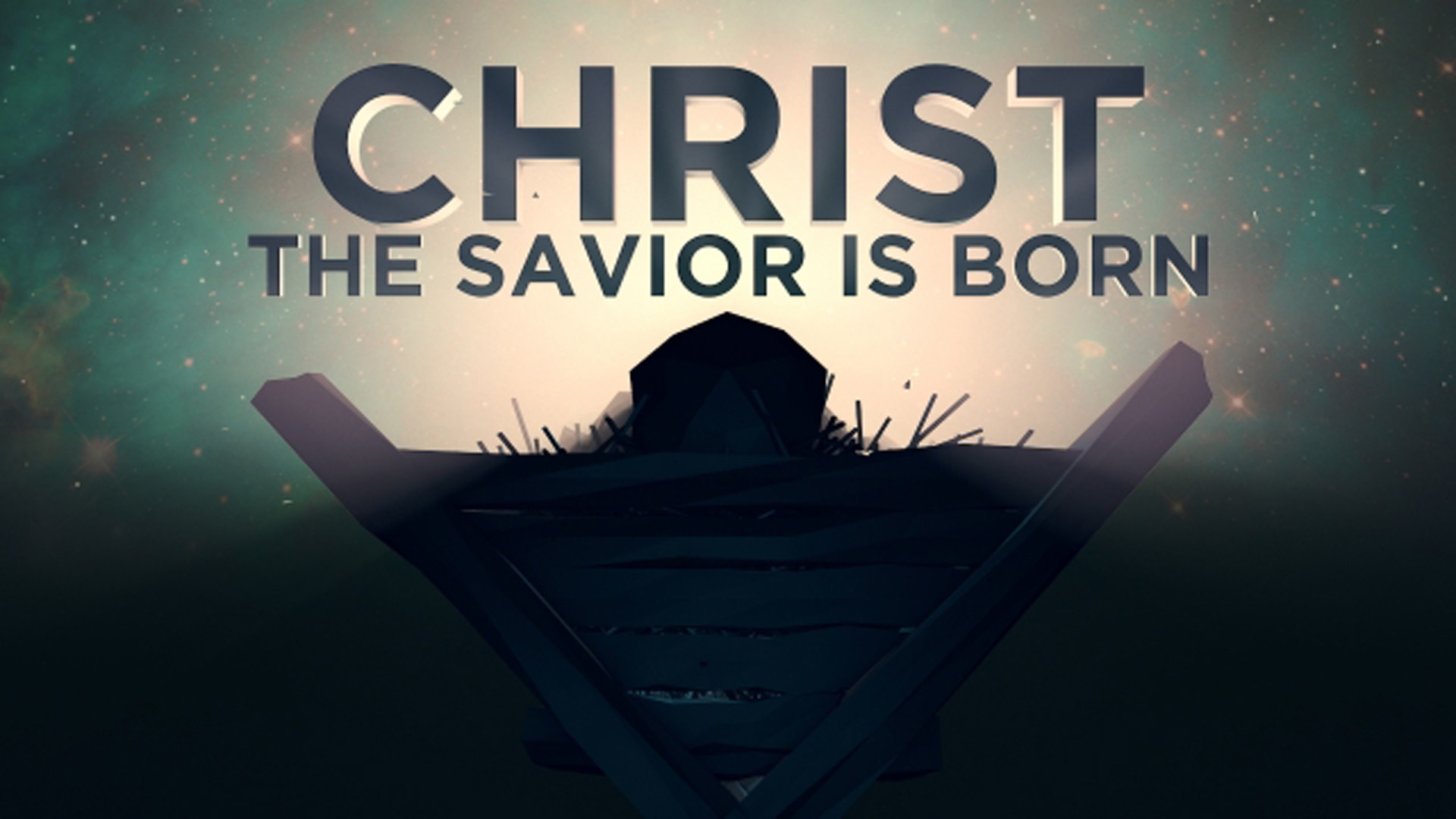
Matthew and Luke are the only two Gospel writers who include an infancy narrative in their biographies of Jesus. According to the most widely accepted theory about how the Gospels were composed, Matthew and Luke wrote independently of one another. That is, Matthew did not have a copy of Luke’s Gospel on his desk when writing his Gospel, as it were, and vice versa.
Having said that, it is amazing that these two birth narratives almost never cover the same events! But in the few instances that they do, they are in agreement. The famous biblical scholar Father Raymond Brown pointed out eleven points (reproduced in Monette, The Wrong Jesus, pp. 108-109) at which Matthew and Luke’s accounts are in accord with one another:
1. Mary and Joseph are legally engaged but haven’t lived together (see Matthew 1:18; Luke 1:27,34).
2. Joseph is from King David’s lineage (see Matthew 1:16,20; Luke 1:27,32; 2:4).
3. Angels announce the forthcoming birth of the baby (see Matthew 1:20-23; Luke 1:30-35).
4. Mary becomes pregnant as a virgin (see Matthew 1:20,23,25; Luke 1:34).
5. The child is conceived through the work of the Holy Spirit (see Matthew 1:18,20; Luke 1:35).
6. An angel proclaims that the child’s name will be Jesus (see Matthew 1:21; Luke 1:31).
7. An angel states that Jesus is to be the Saviour (see Matthew 1:21; Luke 2:11).
8. The birth of Jesus happens after Mary and Joseph began living together as spouses (see Matthew 1:24-25; Luke 2:5-6).
9. Jesus is born in Bethlehem (see Matthew 2:1; Luke 2:4-6).
10. Herod the Great is in power during the time of the birth of Jesus (see Matthew 2:1; Luke 1:5).
11. Jesus is raised in Nazareth (see Matthew 2:23; Luke 2:39).
The fact that these two independent sources on Jesus’ infancy are in agreement on all these major details gives us greater confidence that we can trust these accounts.
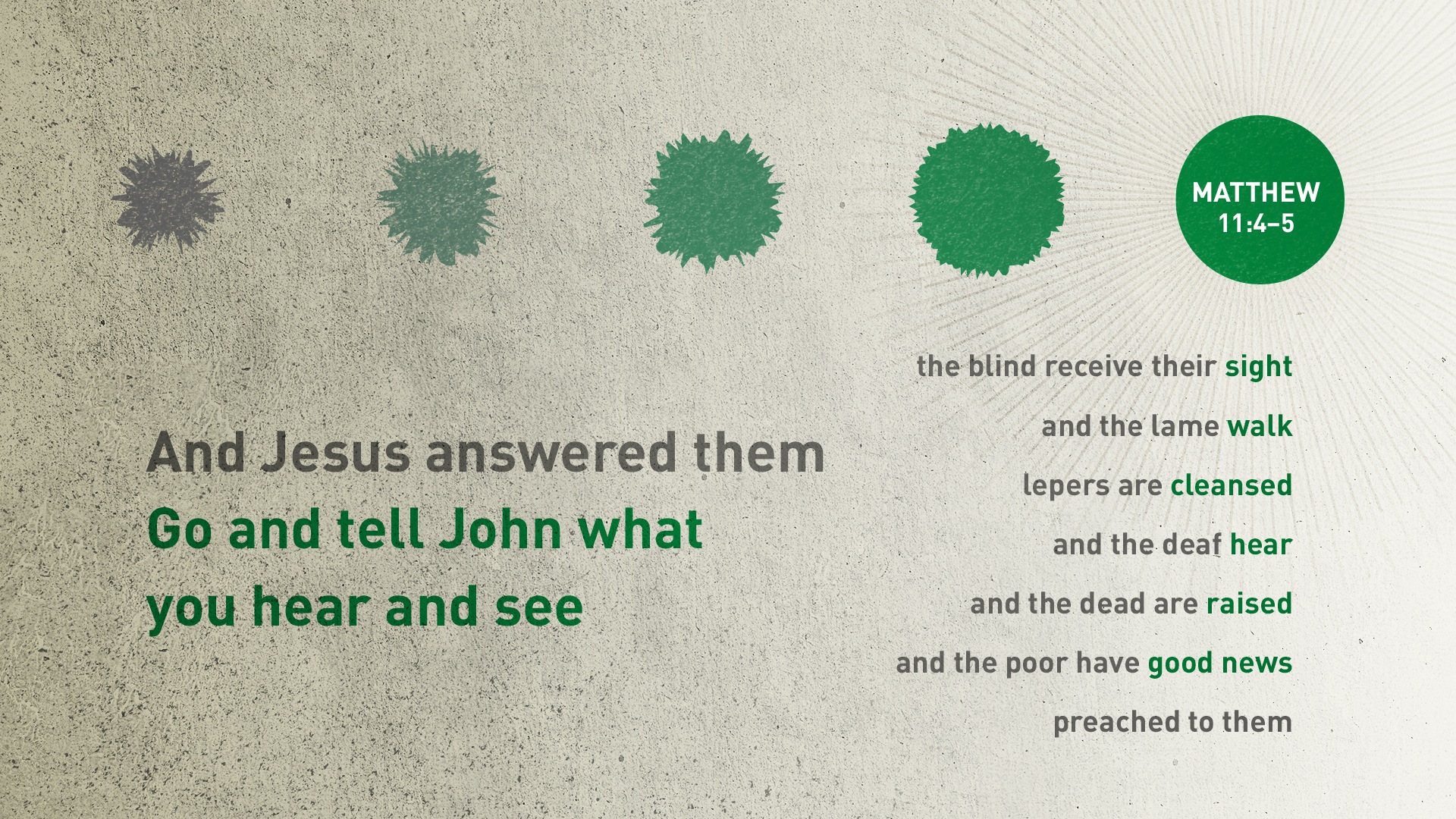
In this Sunday’s Gospel reading (Matt 11:2-11), John the Baptist, who by this time has been imprisoned by Herod, sends messengers to ask Jesus if he is the promised Messiah. Have you ever wondered why John did that? Have you ever wondered why Jesus doesn’t simply answer, “Yes”? Read on!
Indeed, Jesus’ reply to the imprisoned John the Baptist (Matt 11:2–6; cf. Luke 7:18–23) is seen by some commentators as not Messianic. Some have even gone so far as to suggest that Jesus never personally believed he was the Messiah. When asked “Are you he who is to come, or shall we look for another?” (Matt 11:3), Jesus answers in what appears to be a vague manner, using words from Isaiah 61: “Go and tell John what you hear and see: the blind receive their sight and the lame walk, lepers are cleansed and the deaf hear, and the dead are raised up, and the poor have good news preached to them. And blessed is he who takes no offense at me” (Matt 11:4-6).
A very important clue as to why Jesus answered the way he did was discovered in the Dead Sea Scrolls. The Scrolls were written roughly around the time of the Advent of Jesus Christ – between the last three centuries BC and the first century AD. Although they were composed by a sectarian, apocalyptic Jewish sect, they do shed light on what Jews who were roughly contemporaneous to Jesus believed about the coming Messiah.
One of the most important Scrolls that was discovered, known as 4Q521, says this:
For the heavens and the earth will listen to his Messiah…For he will honour the devout upon the throne of eternal royalty, freeing prisoners, giving sight to the blind, straightening out the twisted…and the Lord will perform marvellous acts…for he will heal the badly wounded and will make the dead live, he will proclaim good news to the meek, give lavishly to the needy, lead the exiled, and enrich the hungry.
One can easily see by comparing these two texts why it was that John asked the question about Jesus’ Messiahship, and why Jesus replied the way he did. It was assumed that when the Messiah arrived, according to 4Q521, “prisoners would be set free”. The righteous John, at this time languishing in Herod’s prison fortress at Machaerus, is wondering why Jesus hasn’t sprung him in a “prison break” of sorts. Jesus replies to John by noting that his marvellous works indeed match up with the deeds of the expected Messiah, in line with the teaching of Isaiah 61 and 4Q521. For Jesus to be any more explicit than this would arouse the attention of the secular authorities, prior to the completion of his Messianic mission. However, attentive Jews would have understood Jesus’ claims. Thus, in a culturally relevant manner, Jesus is inviting his fellow Hebrews to consider the evidence of his ministry and draw their own conclusions.

On this Second Sunday of Advent, we encounter the figure of John the Baptist in the Gospel reading (Matthew 3:1-12):
John the Baptist appeared, preaching in the desert of Judea
and saying, “Repent, for the kingdom of heaven is at hand!”
It was of him that the prophet Isaiah had spoken when he said:
A voice of one crying out in the desert,
Prepare the way of the Lord,
make straight his paths.
John wore clothing made of camel’s hair
and had a leather belt around his waist.
His food was locusts and wild honey.
At that time Jerusalem, all Judea,
and the whole region around the Jordan
were going out to him
and were being baptized by him in the Jordan River
as they acknowledged their sins.
When he saw many of the Pharisees and Sadducees
coming to his baptism, he said to them, “You brood of vipers!
Who warned you to flee from the coming wrath?
Produce good fruit as evidence of your repentance.
And do not presume to say to yourselves,
‘We have Abraham as our father.’
For I tell you,
God can raise up children to Abraham from these stones.
Even now the ax lies at the root of the trees.
Therefore every tree that does not bear good fruit
will be cut down and thrown into the fire.
I am baptizing you with water, for repentance,
but the one who is coming after me is mightier than I.
I am not worthy to carry his sandals.
He will baptize you with the Holy Spirit and fire.
His winnowing fan is in his hand.
He will clear his threshing floor
and gather his wheat into his barn,
but the chaff he will burn with unquenchable fire.”
John is dripping with not only honey, but with Old Testament motifs. He’s really the last prophet of the Old Covenant, bridging it with the New Covenant (Testament) of Jesus Christ. He is Elijah redux, to be sure, but I want to focus here on a somewhat overlooked section of John’s speech: “And do not presume to say to yourselves, ‘We have Abraham as our father.’ For I tell you, God can raise up children to Abraham from these stones” (Matt 3:9). What stones? And what do they mean?
Near the location where John was speaking, Joshua had set up twelve stones by the Jordan River as a memorial of God’s deliverance of the twelve tribes (Joshua 4). The twelve stones reappear in the time of Elijah, who built an altar with them (1 Kings 18:31-32). When one recalls Jesus’ identification of John with Elijah (Mark 9:13), and John’s own adaptation of Elijah’s very dress, this is instructive. As Elijah once did, John is calling Israel’s twelve tribes to repent, and prepare for the coming of Israel’s Messiah.
There is also a wordplay in effect: the Hebrew word for “stone” (eben) sounds like the Hebrew term for “son” (ben). John is essentially saying that God can obtain new children of his own from elsewhere; Israelites who remain unrepentant and faithless can’t rely on their pedigree alone for salvation; they must repent and become obedient to the teaching of the coming Anointed One.
Today’s Catholics also can’t rely on their baptism alone, their membership in the Church (the new Israel), as a “golden ticket” for salvation. One must ratify one’s baptism by remaining in friendship with God, obedient to Jesus Messiah. Advent offers us a wonderful chance to repent if we haven’t always done so. We must prepare for not only Christmas, the feast of Jesus’ first arrival, but the coming Parousia, Christ’s Second Advent, inexorably approaching.

As we continue through this month of November, we’re getting closer and closer to the end of the liturgical year. This month has also seen us celebrate the feasts of All Saints and All Souls. So, it is a natural thing to think about our final end as we approach the end of another Church year. It’s also, of course, profitable to “begin with the end in mind”, to consider how our supernatural destiny following death affects our purpose in daily life.
Here are four thought-provoking verses from the New Testament that shed light on this:
1) “You, therefore, must be perfect, as your heavenly Father is perfect” (Matthew 5:48).
In these words from the Sermon on the Mount, Jesus is preaching to the vast crowds. He is not speaking only to his “priests” (the Apostles). In other words, the Lord expects all baptized believers to be saints – not just priests, nuns, and monks. This is the “universal call to holiness”, which Vatican II reminded us of. It is both as old and as new as the Gospel.
2) “This is the will of God, your sanctification” (1 Thessalonians 4:3).
Many people wander through life wondering what God’s will for them might be. Saint Paul spells it out to the Thessalonians: God’s will is that you become a saint. His will is that you be holy, that you be sanctified. And what does it mean to become a saint? Nothing more than becoming the best version of yourself, the masterpiece God had in mind when he created you. In the verses that follow, St Paul also spells out some obvious facets of the life of sanctity, including avoiding immorality.
3) “He (God the Father) chose us in him (Christ) before the foundation of the world, that we should be holy and blameless before him” (Ephesians 1:4).
Saint Paul writes here to the Ephesian Church, reminding them of God’s plan for them from all eternity: that they would be saints. Paul was writing to a group that included many ordinary, everyday Christians: blacksmiths, metalworkers, and others involved in the trades. God expected the same sanctity from them as he did from Paul. The same is also true, of course, for you and I.
4) “Without holiness, no one will see the Lord” (Hebrews 12:14).
All of us want to go to heaven after we die. All of us want to see Jesus face-to-face. The writer of Hebrews gives us some straight talk: only saints get into heaven. So, if you want to go there, get serious about your spiritual life. Satan likes to trick us with the lie that there are three different kinds of people: those who are obviously saints, those who are obviously evil, and regular people like you and me. But we read in the parables of Jesus in the Gospels about many “normal, good people” who didn’t make it to heaven, because they failed to take God seriously: the “foolish virgins”, for example (Matthew 25:1-13), or those who refused the invitation to the wedding feast because they were too “busy” (Luke 14:15-24). If your goal is to get into heaven “by the skin of your teeth”, what happens if you miss your target? Rather, we should make up our minds to become saints. We can, with God’s help.
Are there other biblical verses that you have found helpful in responding to the call to holiness? Share this post and your answer on Twitter, Facebook, or LinkedIn.
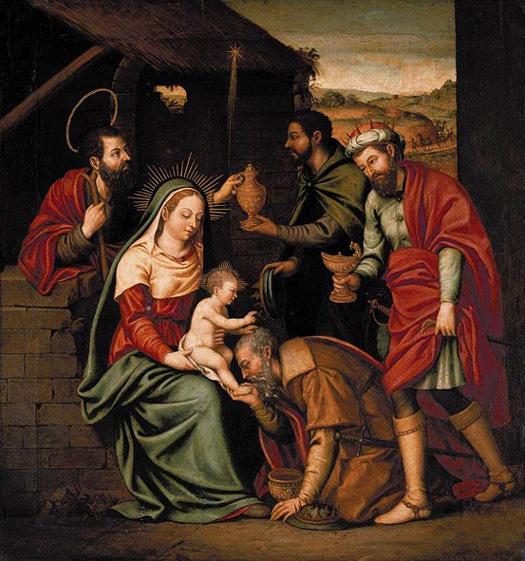 Q. Today we celebrate the Epiphany of the Lord. Can you explain the meaning of this feast?
Q. Today we celebrate the Epiphany of the Lord. Can you explain the meaning of this feast?
A. The word Epiphany means “manifestation (of God)”. In Matthew’s Gospel, there is a great concern to reveal, or “manifest” Jesus as the divine yet human “Son of David”, the true heir to David’s throne (Matthew 1:1). It’s interesting to note that the term “Kingdom of God”, so crucial in Jesus’ teaching, does actually have Old Testament roots. However, the key to understanding the phrase is this: the only time it was ever used there was in reference to David’s Kingdom.
This is intentional on Jesus’ part; in fact, as he assembles his New Covenant Kingdom, Jesus incorporates many of the features of the Old Covenant Kingdom of God, David’s Kingdom. For example, Peter as Pope holds the equivalent of the OT office of “Prime Minister” (see Isaiah 22), one of a cabinet of twelve apostles, representing the twelve tribes of Israel in David’s Kingdom.
Who was the original “Son of David”? Solomon. Solomon, like Jesus, was known as an exorcist, although Jesus’ powers are orders of magnitude greater in this regard. Solomon also was known for his exceptional wisdom, and once again Jesus bests him in this arena, too (think of, for example, Jesus’ brilliant answer to the question about paying taxes to Caesar).
Q. Who was the Queen in Solomon’s Kingdom, and is there a corresponding office in Jesus’ Kingdom?
A. Solomon, of course, had many wives and concubines, which was utterly displeasing to God. However, this was a common practice for kings in antiquity, as marrying foreign wives was a way to consolidate power by means of political alliances. But these wives ultimately turned Solomon’s heart away from the Lord, contributing to his downfall.
This gave rise to a very practical question: with so many wives, who would be the queen? It’s not as if there would be a mud-wrestling match of sorts between them all to determine which woman would gain the throne next to that of the king. The answer to the dilemma was very simple: the queen would be the queen mother, known in Solomon’s Kingdom as the Gebirah. In Solomon’s case, the Queen Mother was Bathsheba, and the Old Testament shows how people would approach her in order to receive an appointment with, or gain favours from, the king.
The New Covenant example is obvious: Matthew takes great pains to show how Mary is the Queen Mother of the Kingdom of the new Son of David, Jesus. In Chapter 2:1-12, international figures pay royal tribute to the new king, seated with his mother. Solomon and Bathsheba are “types” prefiguring Jesus and Mary.
Psalm 72 (of Solomon, no less), is about kings from distant lands who pay tribute to the Davidic King:
1 (A Psalm of Solomon.) Give the king thy justice, O God, and thy righteousness to the royal son! 2 May he judge thy people with righteousness, and thy poor with justice! 3 Let the mountains bear prosperity for the people, and the hills, in righteousness! 4 May he defend the cause of the poor of the people, give deliverance to the needy, and crush the oppressor! 5 May he live while the sun endures, and as long as the moon, throughout all generations! 6 May he be like rain that falls on the mown grass, like showers that water the earth! 7 In his days may righteousness flourish, and peace abound, till the moon be no more! 8 May he have dominion from sea to sea, and from the River to the ends of the earth! 9 May his foes bow down before him, and his enemies lick the dust! 10 May the kings of Tarshish and of the isles render him tribute, may the kings of Sheba and Seba bring gifts! 11 May all kings fall down before him, all nations serve him! 12 For he delivers the needy when he calls, the poor and him who has no helper. 13 He has pity on the weak and the needy, and saves the lives of the needy. 14 From oppression and violence he redeems their life; and precious is their blood in his sight. 15 Long may he live, may gold of Sheba be given to him! May prayer be made for him continually, and blessings invoked for him all the day! 16 May there be abundance of grain in the land; on the tops of the mountains may it wave; may its fruit be like Lebanon; and may men blossom forth from the cities like the grass of the field! 17 May his name endure for ever, his fame continue as long as the sun! May men bless themselves by him, all nations call him blessed! 18 Blessed be the LORD, the God of Israel, who alone does wondrous things. 19 Blessed be his glorious name for ever; may his glory fill the whole earth! Amen and Amen! 20 The prayers of David, the son of Jesse, are ended.
Of special note are these verses: “May the kings of Tarshish and of the isles render him tribute, may the kings of Sheba and Seba bring gifts! May all kings fall down before him, all nations serve him!” (vv. 10-11), and “Long may he live, may gold of Sheba be given to him!” (v. 15a). This episode from Solomon’s reign, is, in a sense, being recapitulated in Jesus’ life. The message is clear: Jesus is the King; he can be found close to his Mother, our Queen, who gains access for us to the royal “Throne Room”, where we pay Jesus the tribute of our lives, make our requests known to him, and receive his favor.
Don’t miss Dr Craig Evans live at The Faith Explained Conference on September 27. Cardinal Thomas Collins will also speak, so grab your tickets here while you still can! Check out Dr Evans’ response to Bart Ehrman in this YouTube clip.


